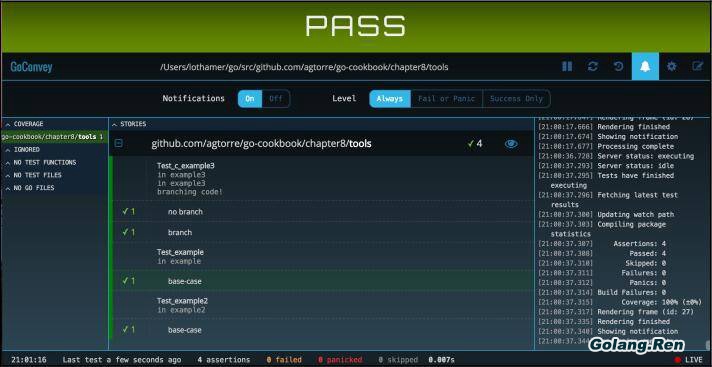Go测试有许多有用的工具。 这些工具可以让你更容易地了解每个功能级别的代码覆盖率,还可以使用断言工具来减少测试代码行。 本文将介绍 github.com/axw/gocov和github.com/smartystreets/goconvey 软件包,以展示其中的一些功能。此外 github.com/smartystreets/goconvey 包支持断言和运行时测试。
实践
获取第三方库:
go get github.com/axw/gocov
go get github.com/smartystreets/goconvey/建立 funcs.go:
package tools
import (
"fmt"
)
func example() error {
fmt.Println("in example")
return nil
}
var example2 = func() int {
fmt.Println("in example2")
return 10
}建立 structs.go:
package tools
import (
"errors"
"fmt"
)
type c struct {
Branch bool
}
func (c *c) example3() error {
fmt.Println("in example3")
if c.Branch {
fmt.Println("branching code!")
return errors.New("bad branch")
}
return nil
}建立 funcs_test.go:
package tools
import (
"testing"
. "github.com/smartystreets/goconvey/convey"
)
func Test_example(t *testing.T) {
tests := []struct {
name string
}{
{"base-case"},
}
for _, tt := range tests {
Convey(tt.name, t, func() {
res := example()
So(res, ShouldBeNil)
})
}
}
func Test_example2(t *testing.T) {
tests := []struct {
name string
}{
{"base-case"},
}
for _, tt := range tests {
Convey(tt.name, t, func() {
res := example2()
So(res, ShouldBeGreaterThanOrEqualTo, 1)
})
}
}建立 structs_test.go:
package tools
import (
"testing"
. "github.com/smartystreets/goconvey/convey"
)
func Test_c_example3(t *testing.T) {
type fields struct {
Branch bool
}
tests := []struct {
name string
fields fields
wantErr bool
}{
{"no branch", fields{false}, false},
{"branch", fields{true}, true},
}
for _, tt := range tests {
Convey(tt.name, t, func() {
c := &c{
Branch: tt.fields.Branch,
}
So((c.example3() != nil), ShouldEqual, tt.wantErr)
})
}
}运行:
$ gocov test | gocov report
ok github.com/agtorre/go-cookbook/chapter8/tools 0.006s
coverage: 100.0% of statements
github.com/agtorre/go-cookbook/chapter8/tools/struct.go
c.example3 100.00% (5/5)
github.com/agtorre/go-cookbook/chapter8/tools/funcs.go example
100.00% (2/2)
github.com/agtorre/go-cookbook/chapter8/tools/funcs.go @12:16
100.00% (2/2)
github.com/agtorre/go-cookbook/chapter8/tools ----------
100.00% (9/9)
Total Coverage: 100.00% (9/9)执行goconvey命令,会在浏览器中显示:

说明
本节演示了如何使用goconvry。与前面的小节相比,Convey关键字基本替代了t.Run,并且可以生成在goconvey生成的UI中显示的标签,但与t,Run的表现有所不同。如果你有嵌套的这样测试块:
Convey("Outer loop", t, func(){
a := 1
Convey("Inner loop", t, func() {
a = 2
})
Convey ("Inner loop2", t, func(){
fmt.Println(a)
})
})使用goconvey命令,将打印1。如果我们使用t.Run,将打印2。换句话说,t.Run按顺序运行测试,永远不会重复。此行为对于将变量设置在外部代码块中非常有用。如果混合使用,就必须记住这种区别。
在使用convey断言时,在UI中有成功的复选标记和其他统计信息。使用它还可以减少if检查单行的大小,甚至可以创建自定义断言。
如果保留goconvey Web界面并打开通知,则在保存代码时,将自动运行测试,并且将收到有关任何增加或减少覆盖范围以及构建失败时的通知。
以上功能都可以单独或一起使用。
在努力提高测试覆盖率时,gocov工具非常有用。它可以快速识别尚未测试的函数,并帮助了解覆盖率报告。此外,gocov可用于生成使用 github.com/matm/gocov-html 包随Go代码一起提供的备用HTML报告。

